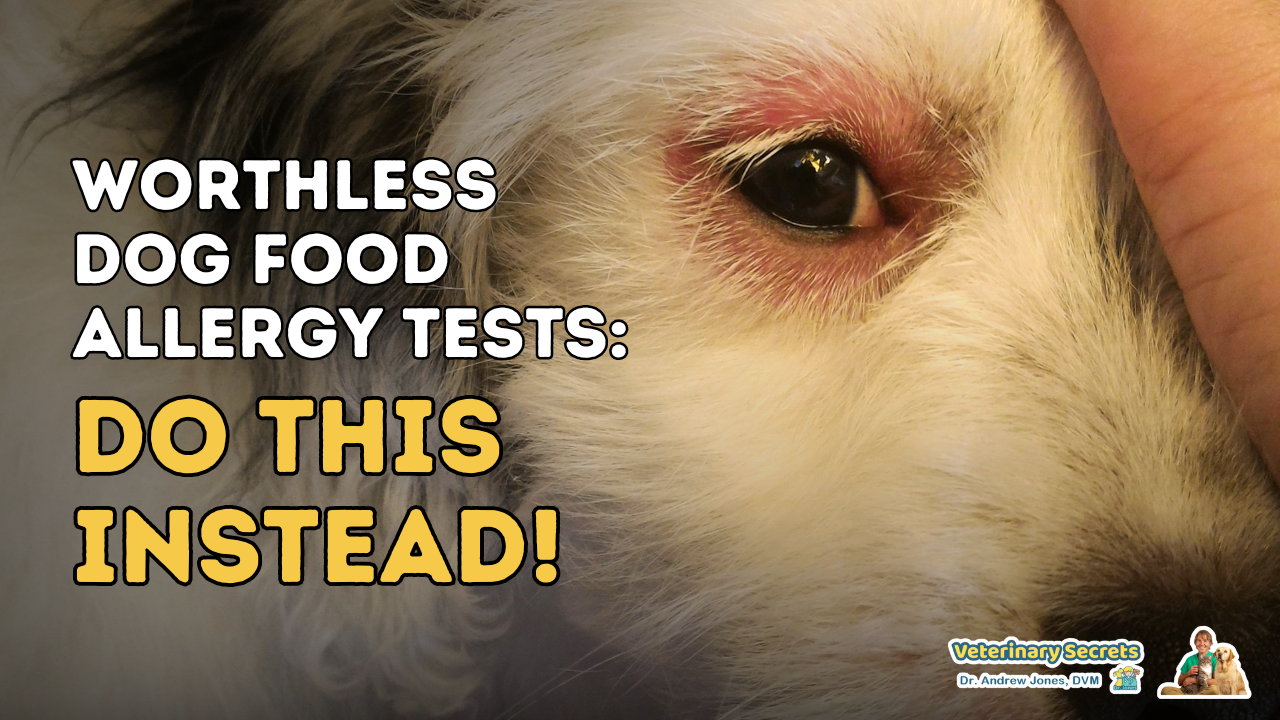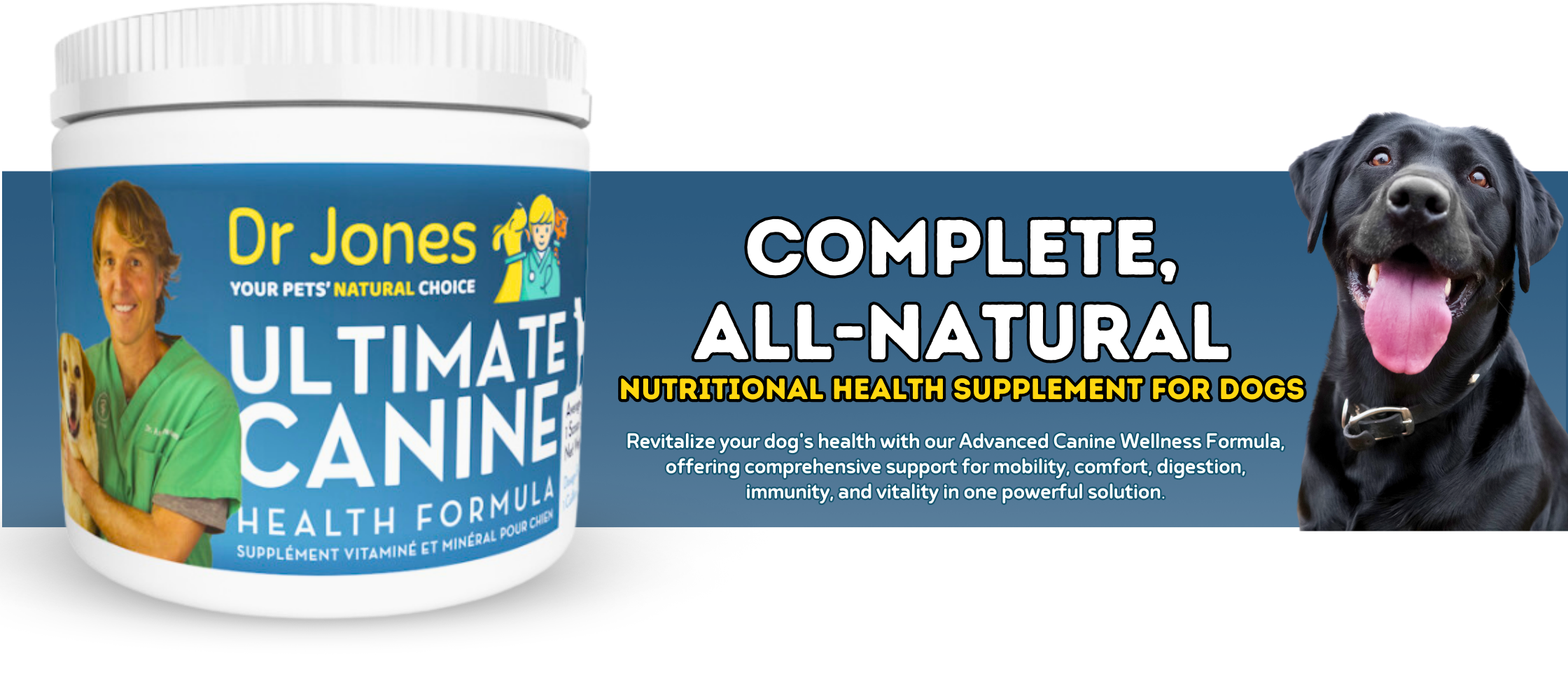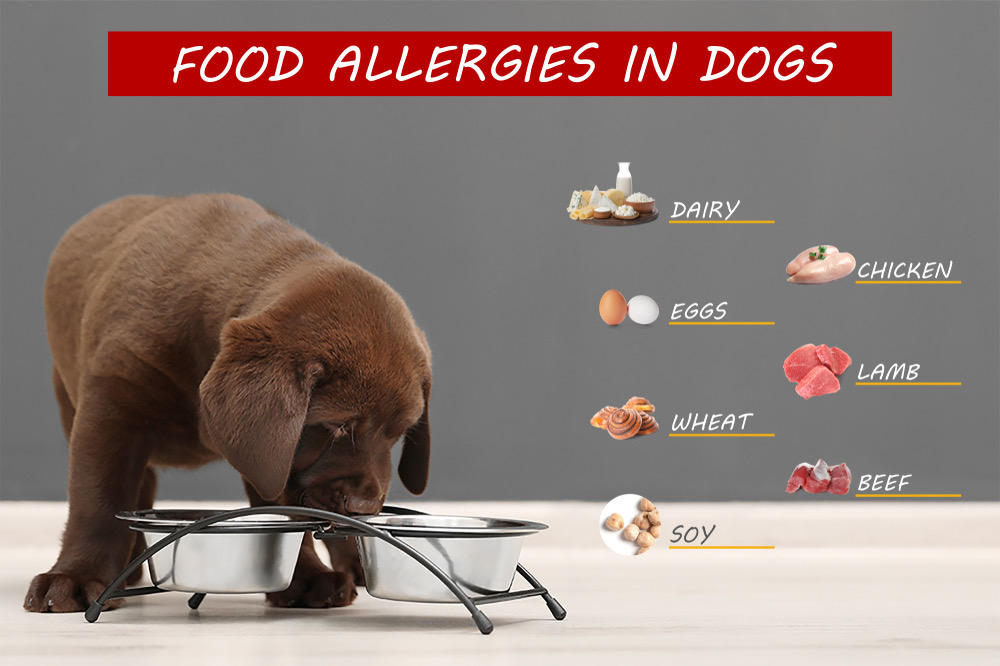Worthless Dog Food Allergy Tests: Do this Instead!

You have not likely done a proper food trial for your allergic dog. In this newsletter I’ll show you an easier way.
Some dogs are now allergic to chicken, so we have just finished our NEW hypoallergenic Dr Jones’ ULTIMATE Canine Health Formula Salmon flavor, and now is a great time to try it 🙂
Dr Jones’ Ultimate Canine Health Formula Salmon or Original.

Rule out Dog Food Allergy with a Food Trial
Up to 15% of dogs can have a food allergy
“The most common food allergens in dogs are proteins… ."
The most common food allergens in dogs are proteins, especially those from dairy, beef, chicken, chicken eggs, soy, or wheat gluten. Virtually any food ingredient can produce an allergy, however. Proteins are the most common culprits but other substances and additives can also be responsible.
There are no diets that are completely “hypoallergenic", meaning that they will not cause allergies. The closest we have to this kind of a diet are the hydrolyzed diets that can be purchased through veterinarians. Dogs and cats can be allergic to pretty much any protein or carbohydrate ingredient that can be found in pet food.
Diagnosis of food allergies
There really isn’t an easy test. While many tests – using blood, saliva, and even hair – that can be performed a veterinarian or purchased by a pet owner online (there is no proof that they work.
None of the currently available tests have been shown to be accurate.
The “gold standard" or best method that we currently have, for diagnosing food allergies is the dietary elimination trial.
To be a true elimination trial for your dog, this special diet must not contain any ingredients that it has eaten in the past. It also requires that no other foods, treats, or supplements are fed during the trial period, including flavored vitamins and certain parasite preventives.
If your dog’s allergy symptoms resolve while on the food trial, the next step is to perform a food challenge by re-introducing your dog’s old food. If your dog’s symptoms resolve with the food trial AND return within one week of a food challenge, your dog has been definitively diagnosed with a food allergy.
Veterinary Diets:
Veterinary hydrolyzed protein diets, in which the protein molecules are broken down to a size too small to be recognized by your dog’s immune system (e.g., Hill’s Prescription Diet z/d, Royal Canin Hypoallergenic Hydrolyzed Protein or Anallergenic?, and Purina ProPlan Veterinary Diets HA Hydrolyzed).
Rule out Food Allergy with a Simple Homemade Dog Food Trial
- 1/3 Turkey, (1 lb), chopped and cooked
- 1/3 Carb of Brown Rice (2 cups) cooked
- 1/3 Veggie (ie Kale) (2 cups), cook with turkey, or frozen mixed veggies (1 cup)
- Sunflower Oil (2 tablespoons)
- Krill oil, 1000mg
- Calcium, 1 teaspoon (1500mg) . This is less critical for a food trial, only really needed if this diet is being fed long term. If adding in, consider the powder as now many dogs have allergies to eggs. (ie avoid eggshells)
For a 50lb dog, feed 1/2 of this twice day. (2 cups, twice daily)
Feed this as the ONLY food to your dog for a minimum of 6 weeks, ideally for 12 weeks.
80% of dogs respond by 6 weeks.
Best Wishes,
Dr. Andrew
P.S. Dr. Jones’ Ultimate Canine Health Formula has been used by OVER 10, 000 dog owners with some wonderful results and reviews!
P.P.S. NOW is a great time to try our NEW hypoallergenic Salmon flavor, or Original Formul.


Dr jones, when preparing this recipe for several days at a time ,should mix the calcium and the krill to the whole recipe or break it down to individual bowls and how much?
You can prepare in batches
Doctor Jones,quiero consultar sobre mi perro, es un Cookapoo va a tener dos años en Marzo, y hoy luego de bañarlo le encontré cierto tipo de descamación en su hocico. Podría ayudarme con su diagnóstico y tratamiento? por favor ! Muchas gracias.
Here are some statements from one of our articles related to your topic:
From your description I would suspect that your dog has a form of an immune system disease called discoid lupus. The immune system attacks the end of the nose turning it pink and producing secondary scabs and cracks. Treatment can be topical steroids, Vitamin E and sunscreen in the sun. I would still recommend you see your veterinarian as the lips are also involved – they may want to do a biopsy to know exactly what is going on.
The rash on the chin that you describe sounds like some sort of muzzle pyoderma (skin infection). It could be caused by bacteria and then topical medication may work or it could be caused by a skin mite called demodex. I would recommend a trip to your veterinarian. You can use a topical antiseptic medication washing the area twice daily with hibitane ( available at the pharmacy) and supplement with Vit E at 400 IU every 12 hours ( give in his food). The Vit E is a good immune stimulant for the skin.
Hello doctor, my labradoodle cant stop licking his foot and bite i took to the veterinary and he say maybe was food allergies i change his food but he still doing hte same. What is your advice?
Excessive Paw Licking In Dogs
Does your dog CONSTANTLY lick his paws?
Lick. Lick. Lick.
It can be very frustrating as a pet parent, especially when some of the things you try are not working.
The most common cause of excessive paw licking is an underlying allergy, making the feet itchy, causing your dog to lick.
Typically the feet become stained from the salivary pigments, so often is the dogs with white fur they become a reddish brown.
The moisture caused by excessive foot licking between the paws can cause a secondary bacterial or yeast infection. This can actually worsen the itchiness and clinical signs.
Allergy is defined as a hypersensitivity in which exposure to a benign protein (allergen) causes your pet’s immune system to overreact.
In both people, and dogs and cats, the incidence of allergies is increasing.
CAUSES
Three main possibilities: external parasites, such as fleas; food–for dogs, beef protein is the most common; environmental, from pollens to house dust mites. The immune system overreacts and causes severe itchiness.
SOLUTIONS
1. ELIMINATE the fleas. Practice regular flea control using natural methods, if possible, topical antiparasitics, if necessary.
2. Hypoallergenic Food Trial
Here you are feeding a hypoallergenic diet for ten to twelve weeks to see ifyour dog or cat’s allergic symptoms stop. This is a long time, and fortunately over 80 percent of pets respond at least partially by six weeks, although Labs and cocker spaniels usually need longer trials.
3. THE SUPPLEMENT CONNECTION. Fatty acid supplements are very helpful in decreasing the level of inflammation. Omega-3 fatty acids are most important. The main point is to give a high enough dose to be effective, and the ideal dose is 1,000mg per ten pounds daily. A great, inexpensive source is flax oil; I give 1 tablespoon per fifty pounds. Other sources include primrose oil and specific veterinary supplements.
4. FEET WASHING. Regularly washing of your dog’s paws after they come in from being outside is one of the best ways to decrease the itching; this washes off the outdoor allergens. You can use a damp cloth or put your pup in the bath.
5. SOOTHE IT TOPICALLY. HERBAL CREAMS. There are a few herbs to consider topically: Licorice gel, chamomile cream, and topical curcumin.
Licorice and curcumin ointment are herbal medications that has been successfully used to relieve the itch. Apply a thin coat twice daily to affected areas.
6. ANTIHISTAMINES. Benadryl is the most commonly used antihistamine. It is given at a dose of 1 mg per pound of body weight, two to three times a day. It is best to consult your veterinarian before using these medications. It often takes fourteen days of using these to see if they are helping.
7. Treat the YEAST. Yeast are often a secondary organism that grows on your dog’s skin with underlying allergies and paw licking. One option is to make your own anti-yeast wash of 1 cup of green tea, 2 tablespoons of Apple Cider Vinegar – wipe your dog’s paws with this mixture twice daily. Another option is to purchase a ‘human’ OTC anti-fungal cream such as Canesten and apply that twice daily as needed.
P.S. Dog Paw Licking is often difficult to treat, and usually means ongoing treatment – in general veterinary medications such as prednisone are only stopping the symptoms, NOT getting to the underlying cause.
They also often have side effects such as Increased drinking, Increased urination, – never mind less common ones such as diabetes.